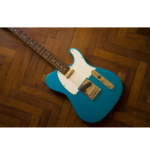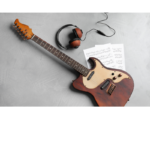The blues scales in A is a fundamental component of many guitarists’ repertoires, offering a versatile and expressive palette for solos and improvisation. Central to this scale is the A minor pentatonic scale, a five-note scale that serves as the foundation for countless blues, rock, and jazz licks. In this blog post, we’ll explore the A minor pentatonic scale, delve into its modes, and demonstrate how to use it effectively with guitar tabs that have their roots on the 6th string.
Understanding the A Minor Pentatonic Scale
The A minor pentatonic scale consists of five notes: A, C, D, E, and G. These notes create a simple yet powerful scale that can be used to craft compelling solos and melodies. Here is the formula for the A minor pentatonic scale:
- Root (A)
- Minor Third (C)
- Perfect Fourth (D)
- Perfect Fifth (E)
- Minor Seventh (G)
When laid out on the guitar, this scale pattern can be played in various positions along the neck. Let’s start with the most common position, known as Position 1, where the root note (A) is on the 6th string, 5th fret.

Download The FretDeck & Pentatonic Secrets Course!
Download Our Course
Position 1 (Root on 6th string, 5th fret)
e|---------------------5--8-|
B|-----------------5--8-----|
G|-------------5--7---------|
D|---------5--7-------------|
A|-----5--7-----------------|
E|-5--8---------------------|
Exploring the Modes of the A Minor Pentatonic Scale
The A minor pentatonic scale can be played in different positions across the fretboard, each position starting from a different note of the scale. These different positions are known as modes. There are five modes of the A minor pentatonic scale, each with its own unique sound and feel. Let’s explore each mode in detail:
Mode 1: A Minor Pentatonic (Position 1)
We’ve already seen the first mode above. It starts on A and is the most straightforward form of the scale.
Mode 2: C Major Pentatonic (Position 2)
The second mode starts on the second note of the A minor pentatonic scale, which is C. This mode is also known as the C major pentatonic scale.
e|---------------------8--10-|
B|-----------------8--10-----|
G|-------------7--9----------|
D|---------7--10-------------|
A|-----7--10-----------------|
E|-8--10---------------------|
Mode 3: D Dorian Pentatonic (Position 3)
The third mode starts on the third note of the A minor pentatonic scale, which is D.
e|----------------------10--12-|
B|-----------------10--13------|
G|-------------9--12-----------|
D|---------10--12--------------|
A|-----10--12------------------|
E|-10--12----------------------|
Mode 4: E Phrygian Pentatonic (Position 4)
The fourth mode starts on the fourth note of the A minor pentatonic scale, which is E.
e|---------------------12--15-|
B|-----------------13--15-----|
G|-------------12--14---------|
D|---------12--14-------------|
A|-----12--15-----------------|
E|-12--15---------------------|
Mode 5: G Mixolydian Pentatonic (Position 5)
The fifth mode starts on the fifth note of the A minor pentatonic scale, which is G.
e|---------------------15--17-|
B|-----------------15--17-----|
G|-------------14--17---------|
D|---------14--17-------------|
A|-----15--17-----------------|
E|-15--17---------------------|
Connecting the Modes
One of the keys to mastering the A minor pentatonic scale is learning how to connect these modes across the fretboard. This allows for seamless transitions and longer, more fluid solos. Here are a few exercises to help you connect the modes:
Exercise 1: Ascending and Descending Through Modes
Start in Position 1 and move through each mode, ascending and descending the fretboard.
e|-----------------5--8-|-----------------8--10-|-----------------10--12-|-----------------12--15-|-----------------15--17-|
B|-------------5--8-----|-------------8--10-----|-------------10--13-----|-------------13--15-----|-------------15--17-----|
G|---------5--7---------|---------7--9----------|---------9--12----------|---------12--14---------|---------14--17---------|
D|-----5--7-------------|-----7--10-------------|-----10--12-------------|-----12--14-------------|-----14--17-------------|
A|-5--7-----------------|--7--10-----------------|--10--12----------------|--12--15----------------|--15--17----------------|
E|8---------------------|10----------------------|12----------------------|15----------------------|17----------------------|
Exercise 2: Horizontal Movement
Practice moving horizontally along the fretboard by staying on the same string while transitioning between modes.
e|-5--8--10--12--15--17-|
B|-5--8--10--13--15--17-|
G|-5--7--9--12--14--17--|
D|-5--7--10--12--14--17-|
A|-5--7--10--12--15--17-|
E|-5--8--10--12--15--17-|
Practical Application of the A Minor Pentatonic Scale
Now that we’ve covered the positions and modes, let’s look at how to apply the A minor pentatonic scale in your playing. Here are some practical tips and licks to get you started:
Tip 1: Use Bends and Vibrato
Bends and vibrato are essential techniques for adding expression to your playing. Here’s a simple lick that incorporates a bend:
e|---------------------------------|
B|------8b10r8--5------------------|
G|-----------------7--5h7p5--------|
D|--------------------------7------|
A|---------------------------------|
E|---------------------------------|
Tip 2: Combine Scale Positions
Mixing notes from different scale positions can create interesting and dynamic solos. Here’s a lick that combines Position 1 and Position 2:
e|----------------------------------------|
B|--5--8--5-------------------------------|
G|-----------7--5h7p5---------------------|
D|---------------------7--5h7-------------|
A|------------------------------7---------|
E|----------------------------------------|
Tip 3: Use the Blues Note
The blues note (Eb) can add a lot of character to your solos. Here’s a lick that includes the blues note:
e|----------------------------------|
B|------8b10r8--5-------------------|
G|----------------7--5h7p5--8p7-----|
D|-----------------------------7----|
A|----------------------------------|
E|----------------------------------|
Conclusion
Mastering the A minor blues scales in a and its modes can significantly expand your guitar playing capabilities. By practicing the positions, connecting the modes, and incorporating expressive techniques like bends and vibrato, you can develop a unique and compelling blues style. Remember, the key to mastery is consistent practice and experimentation. So, pick up your guitar, explore these scales, and start creating your own soulful blues solos today!

Download The FretDeck & Pentatonic Secrets Course!
Download Our Course









